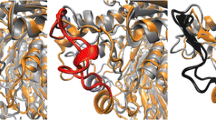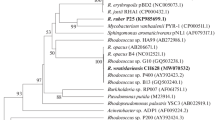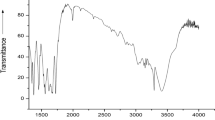Abstract
Halogenated biphenyls are worldwide persistent pollutants of great environmental concern. In particular, polychlorinated biphenyls and polybrominated biphenyls have been globally used for industrial purposes until they were found highly toxic, mutagenic and carcinogenic to humans. Therefore, ecological strategies to remove halogenated biphenyls, such as enzyme-catalyzed degradation, are needed. Here, we studied the effect of substitution of F, Cl, Br or I at the 4,4′-positions of 2,3-dihydro-2,3-dihydroxybiphenyl-2,3-dehydrogenase (BphB) on the degradation of halogenated biphenyls by quantum and molecular mechanics. Results show that Boltzmann-weighted average degradation barriers of substituted BphB are all lower than the unsubstituted biphenyl, except for chlorinated biphenyl. The roles of residues nearby the active site, e.g., isoleucine89, asparagine115, serine142, asparagine143, proline184, methionine187 and threonine189, were also investigated.
Similar content being viewed by others
Avoid common mistakes on your manuscript.
Introduction
Polyhalogenated biphenyls include polyfluorobiphenyls (PFBs), polychlorinated biphenyls (PCBs), polybrominated biphenyls (PBBs) and polyiodobiphenyls (PIBs). They are widely used as hydraulic fluids, plasticizers and flame retardants. PCBs and PBBs have been discontinued in many countries as they were found highly mutagenic and carcinogenic to humans (Srogi 2008; Dsikowitzky and Schwarzbauer 2014; Nidheesh 2018). Due to their persistence and bioaccumulation, PCBs and PBBs have become ubiquitous pollutants in mobile environmental reservoirs and food chain, which have caused serious threats to human health (Kuswandi 2018; Sharma and Roy 2018). Environmental biotransformation is an excellent method that can provide solutions with the lowest input and has received worldwide acceptance to treat biphenyl and polyhalogenated biphenyls (Dannan et al. 1982). Previous structural, molecular docking and biochemical studies reported that dehydrogenase BphB can efficiently degrade biphenyl and polyhalogenated biphenyls (Vezina et al. 2007; Zhuang et al. 2016; Jain et al. 2018; Kulshreshtha 2018).
Four enzymes, BphA (biphenyl dioxygenase), BphB, BphC (dioxygenase) and BphD (hydrolase), are involved in the biphenyl and polyhalogenated biphenyls degradation processes (Field and Sierra-Alvarez 2008; Qu et al. 2013). BphA, the first enzyme in the degradation process, inserts two oxygen atoms into the vicinal ortho-meta carbons of the substrates. BphB, the second enzyme, catalyzes a dehydrogenation reaction. BphC and BphD sequentially metabolize 2,3-dihydroxybiphenyl and finally to 2-hydroxypenta-2,4-dienoic acid (Li et al. 2015). The dehydrogenation step by BphB is crucial in the polyhalogenated biphenyls degradation.
BphB is a dehydrogenase and belongs to a very large short-chain dehydrogenase/reductase family, and the sequence alignments of BphB are similar to its family (Jornvall et al. 1995; Vedadi et al. 2000). The X-ray structure indicates that active residues serine142, deprotonated tyrosine155 and coenzyme NAD (nicotinamide adenine dinucleotide) form the active site of BphB and accommodate substrate polyhalogenated biphenyls through hydrogen bonds (Borja et al. 2005; Piccoli et al. 2014). Structural studies are vital for understanding BphB-catalyzed processes. However, it is still obscure substitution effect that affects the degradation of halogenated biphenyls. Given the environmental importance of PFBs, PCBs, PBBs and PIBs, it is significant and urgent to understand the substitution effect of BphB-catalyzed degradation.
Here, we carried out quantum mechanics/molecular mechanics calculations to investigate the substitution effect of BphB-catalyzed degradation. Quantum mechanics/molecular mechanics method can provide the atomistic details of catalyst mechanisms and has become an increasingly important tool to supplement experimental enzyme chemistry (Muthusaravanan et al. 2018). The degradation details of fluorined, chlorined, bromined and iodined substituents (at 4,4′-positions) of cis-2,3-dihydro-2,3-dihydroxybiphenyl were revealed.
Computational methods
The quantum mechanics (QM) region of the degradation system contains substrates (polyhalogenated biphenyls), deprotonated tyrosine155 and coenzyme nicotinamide adenine dinucleotide (NAD). The entire degradation system was placed in a water sphere with a radius of 41 Å. The employed quantum mechanics/molecular mechanics (QM/MM) method is similar to our previous study (Li et al. 2014; Zhang et al. 2018), so only important details will be briefly summarized here. The QM/MM calculations were performed with the aid of ChemShell platform (Metz et al. 2014), which integrates TURBOMOLE and DL-POLY programs (Smith and Forester 1996). The QM region was treated with B3LYP/cc-pVDZ//CHARMM22 level (Billeter et al. 2000). Single point energy was calculated at the M06-2X/6-311G(d,p)//CHARMM22 level (Qu et al. 2012). The M06-2X/6-311G(d,p)//B3LYP/cc-pVDZ level is an appropriate method for calculations due to the high accuracy of calculation with less computational source. Five different snapshots were extracted every 0.5 ns from 4 to 6 ns of the stochastic boundary molecular dynamic simulations for each degradation systems, which are named bf-4.0, bf-4.5, bf-5.0, bf-5.5, bf-6.0 for the polyfluorobiphenyls degradation process and bb-4.0, bb-4.5, bb-5.0, bb-5.5, bb-6.0 for the polybrominated biphenyls degradation process and bi-4.0, bi-4.5, bi-5.0, bi-5.5, bi-6.0 for the polyiodobiphenyls degradation process. These extracted structures will be treated as the initial configurations in geometry optimization and transition state search.
Results and discussion
According to room-temperature single-molecule experiments, the rate constant of an enzyme-catalyzed reaction shows large fluctuations (Min et al. 2005). Here, the Boltzmann-weighted averaging method was employed to obtain average barrier (Billeter et al. 2000; Lonsdale et al. 2012). In the following paragraphs, the “average barrier” mentioned refers to the Boltzmann-weighted average barrier from five different snapshots.
Reaction mechanism and potential energetic results
The degradation mechanism of halogenated biphenyls by dehydrogenase BphB is presented in Fig. 2, for convenience to describe the reaction mechanism; atoms (1–3 for C, 1–3 for O and 1–3 for H) are labeled in red. The degradation reaction is induced by deprotonated tyrosine155. O1 atom of tyrosine155 can form a hydrogen bond with H1 atom of substrate (O1–H1 bond is 1.64 Å), and this bond formation is accompanied with the O2–H1 bond cleavage (Huelsmeyer et al. 1998). Meanwhile, the leaving H1 is accepted by tyrosine155 which acts as a catalytic base (Kavanagh et al. 2008). H2 atom of substrate is accepted by C2 atom of coenzyme NAD. As shown in Fig. 1, the determined potential barriers for degradation of polyfluorobiphenyls (PFBs), polychlorinated biphenyls (PCBs), polybrominated biphenyls (PBBs) and polyiodobiphenyls (PIBs) fluctuate from 0.30 to 1.92 kcal mol−1, 9.2–13.3 kcal mol−1 (Zhang et al. 2018), 5.7–14.8 kcal mol−1 and 6.1–10.1 kcal mol−1, respectively. The corresponding average barriers are 1.0, 11.5 (Zhang et al. 2018), 9.3 and 9.0 kcal mol−1, respectively. We have previously determined that the average barriers for cis-2,3-dihydro-2,3-dihydroxybiphenyl degradation are 10.7 kcal mol−1 (Zhang et al. 2018). This indicates that except for chlorined biphenyls, BphB can more efficiently catalyze the degradation of fluorined, bromined and iodined biphenyls.
Energy profiles of polyfluorobiphenyls (PFBs), polybrominated biphenyls (PBBs) and polyiodobiphenyls (PIBs) degradation. The barriers of polyfluorobiphenyls are lower than other halogenated biphenyls, illustrating that the 2,3-dihydro-2,3-dihydroxybiphenyl-2,3-dehydrogenase (BphB) can more efficiently catalyze the degradation of polyfluorobiphenyls
Catalytic itinerary and structural details
Since catalytic reaction mainly occurs through the pathway with the lowest energy barrier, pathway bf-4.0 (degradation of PFBs), pathway bb-4.0 (degradation of PBBs) and pathway bi-4.0 (degradation of PIBs) were chosen for the following itinerary calculations. The degradation mechanism of halogenated biphenyls catalyzed by BphB is presented in Scheme 1 of supplement materials. The dimensional structures of the reactant, transition state and product involved in thecis-2,3-dihydro-2,3-dihydroxy-4,4′-difluorobiphenyl degradation of the bf-4.0 pathway are displayed in Fig. 2. The three-dimensional structures of the other two systems are displayed in supplementary material. Crucial intermolecular distances and atomic charges of the reactant, transition state and product of these three substrates degradation pathways are displayed in Fig. 3. In the reactant of polyfluorobiphenyls degradation process (bi-4.0 pathway), serine142, asparagine143, tyrosine155 and coenzyme NAD (nicotinamide adenine dinucleotide) can form a well-defined cavity, and this cavity can interact with the substrate through several hydrogen bonds; this agrees well with the previous structural, molecular docking study (Dhindwal et al. 2011; Pham and Sylvestre 2013). Serine142 and asparagine143 can hold the reactant by forming hydrogen bonds. Two hydrogen bonds can be formed by serine142 and substrate (2.1 and 3.5 Å), and asparagine143 also can form two hydrogen bonds with substrate (1.71 and 2.79 Å). These completely agree with previous experimental results (2.1, 3.5, 1.79 and 2.79 Å) (Dhindwal et al. 2011; Piccoli et al. 2014). The H1 atom is toward the O1 atom of tyrosine155 (the distance of H1–O1 bond is 1.64 Å), and the H2 atom is toward the C2 atom of coenzyme NAD (the distance of H2–C1 bond is 2.24 Å). These conditions are prerequisites for the degradation reaction of polyhalogenated biphenyls by BphB and agree well with Piccoli’s results (Piccoli et al. 2014). In the transition state, the length of O1–H1 bond decreases from 1.64 to 0.99 Å and the distance between the H2 and C2 decreases from 2.24 to 1.09 Å, which indicate that the H1 and H2 protons delivered from substrate to tyrosine155 and coenzyme NAD. In the final product, the C1–O2–H1 and C1–C2–H2 angles are 115.0° and 13.3°, respectively. The distances of H1–O1 and H2–C1 are 0.99 and 1.09 Å. The C1=O2 bond length is 1.25 Å, and the C1 atom has great positive charges, illustrating the generation of C1=O2 bonds. These conditions mean the final product has formed.
Dimensional structures of the reactant, transition state and product involved in the degradation pathway bf-4.0 of the polyfluorobiphenyls degradation. Nicotinamide adenine dinucleotide (NAD) is the coenzyme. The unit of bond distances is in Å. For convenience to describe the reaction mechanism, atoms (1–3 for C, 1–3 for O and 1–3 for H) are labeled in red
Variations of atomic charges and intermolecular distances of several key atoms along degradation of polyfluorobiphenyls (PFBs), polybrominated biphenyls (PBBs) and polyiodobiphenyls (PIBs). In the product, the distances of O1–H1 and H2–C2 decrease and the C1 atom has great positive charge, illustrating that the final product has formed
Individual residue influence
A positive ΔEi−0 value means that neglecting the ith residue will increase the potential barrier and suppress the enzyme reaction (Li et al. 2013). The calculation method of ΔEi−0 value is presented in supplementary materials.
The obtained ΔEi−0 values of these residues are shown in Fig. 4. The potential barrier of the bf-4.0 pathway is only 0.30 kcal mol−1, and the electrostatic influence calculations can explain this very well. In bf-4.0 pathway, all the eight calculated residues facilitate cis-2,3-dihydro-2,3-dihydroxy-4,4′-difluorobiphenyl degradation process, especially serine142. Serine142 significantly facilitates this process and decreases the reaction barrier by about 8.2 kcal mol−1. Residues isoleucine89, asparagine115, proline184, methionine187 and threonine189 also strongly facilitate this process through decreasing the reaction barrier by about 3.1, 3.2, 3.0, 2.9 and 4.0 kcal mol−1, respectively. For bb-4.0 pathway, serine142 facilitates the process through decreasing the reaction barrier by about 1.0 kcal mol−1, and asparagine143 suppresses this degradation reaction. For the bi-4.0 pathway, serine142 facilitates the process through decreasing the reaction barrier by about 3.7 kcal mol−1. In contrast, asparagine143 and lysine159 suppress the degradation process. The other residues are found to perform a negligible influence toward the degradation process. This electrostatic influence analysis highlights asparagine143 and lysine159 as candidate residues for future mutation studies.
Electrostatic influences of eight residues of degradation pathways bf-4.0, bb-4.0 and bi-4.0 during polyfluorobiphenyls (PFBs), polybrominated biphenyls (PBBs) and polyiodobiphenyls (PIBs) degradation processes. It can be noted that all the calculated residues facilitate PFBs degradation processes; this can explain why the degradation barriers of PFBs are lower than other halogenated biphenyls
Conclusion
This work investigated the substitution effect of dehydrogenase BphB-catalyzed degradation of halogenated biphenyls by using the quantum mechanics/molecular mechanics method (QM/MM). The degradation details of fluorined, chlorined, bromined and iodined substituents (at 4,4′-positions) of cis-2,3-dihydro-2,3-dihydroxybiphenyl were revealed. Five snapshots were investigated for each of the halogenated substrates, which consistently revealed that the corresponding Boltzmann-weighted average degradation barriers are all lower than the unsubstituted cis-2,3-dihydro-2,3-dihydroxybiphenyl, except for chlorined biphenyl. Our results deepen the understanding of the BphB-catalyzed degradation processes and can serve as the model for studying other polyhalogenated biphenyls. The electrostatic influence analysis reveals that serine142 facilitates the degradation reaction and residue asparagine143 suppresses the degradation reaction, which may assist searching for new experimental mutation targets for future enzyme modification.
Abbreviations
- BphA :
-
Biphenyl dioxygenase
- BphB :
-
2,3-Dihydro-2,3-dihydroxybiphenyl-2,3-dehydrogenase
- BphC :
-
2,3-Dihydroxybiphenyl-1,2-dioxygenase
- BphD :
-
2-Hydroxyl-6-oxo-6-phenylhexa-2,4-dienoic acid hydrolase
- NAD :
-
Nicotinamide adenine dinucleotide (coenzyme)
- Isoleucine89 :
-
Isoleucine and its sequence number in BphB enzyme
- PFBs :
-
Polyfluorobiphenyls
- PCBs :
-
Polychlorinated biphenyls
- PBBs :
-
Polybrominated biphenyls
- PIBs :
-
Polyiodobiphenyls
- QM/MM :
-
Quantum mechanics/molecular mechanics
- bf-4.0 :
-
The degradation pathway of polyfluorobiphenyls degradation
- bb-4.0 :
-
The degradation pathway of polybrominated biphenyls degradation
- bi-4.0 :
-
The degradation pathway of polyiodobiphenyls degradation
References
Billeter SR, Turner AJ, Thiel W (2000) Linear scaling geometry optimisation and transition state search in hybrid delocalised internal coordinates. Phys Chem Chem Phys 2:2177–2186. https://doi.org/10.1039/a909486e
Borja J, Taleon DM, Auresenia J, Gallardo S (2005) Polychlorinated biphenyls and their biodegradation. Process Biochem 40:1999–2013. https://doi.org/10.1039/a909486e
Dannan GA, Sleight SD, Aust SD (1982) Toxicity and microsomal enzyme induction effects of several polybrominated biphenyls of Firemaster. Fundam Appl Toxicol 2:313–321. https://doi.org/10.1093/toxsci/2.6.313
Dhindwal S, Patil DN, Mohammadi M, Sylvestre M, Tomar S, Kumar P (2011) Biochemical studies and ligand-bound structures of biphenyl dehydrogenase from Pandoraea pnomenusa strain B-356 reveal a basis for broad specificity of the enzyme. J Biol Chem 286:37011–37022. https://doi.org/10.2210/pdb2y93/pdb
Dsikowitzky L, Schwarzbauer J (2014) Industrial organic contaminants: identification, toxicity and fate in the environment. Environ Chem Lett 12:371–386. https://doi.org/10.1007/978-3-319-02387-8_2
Field JA, Sierra-Alvarez R (2008) Microbial transformation and degradation of polychlorinated biphenyls. Environ Pollut 155:1–12. https://doi.org/10.1016/j.envpol.2007.10.016
Huelsmeyer M, Hecht H-J, Niefind K, Hofer B, Eltis LD, Timmis KN, Schomburg D (1998) Crystal structure of cis-biphenyl-2,3-dihydrodiol-2,3-dehydrogenase from a PCB degrader at 2.0 A resolution. Protein Sci 7:1286–1293. https://doi.org/10.2210/pdb2y93/pdb
Jain B, Singh AK, Kim H, Lichtfouse E, Sharma VK (2018) Treatment of organic pollutants by homogeneous and heterogeneous Fenton reaction processes. Environ Chem Lett 16:947–967. https://doi.org/10.1007/s10311-018-0738-3
Jornvall H, Persson B, Krook M, Atrian S, Gonzalez-Duarte R, Jeffery J, Ghosh D (1995) Short-chain dehydrogenases/reductases (SDR). Biochemistry 34:6003–6013. https://doi.org/10.1002/0471203076.emm0342
Kavanagh KL, Jörnvall H, Persson B, Oppermann U (2008) Medium- and short-chain dehydrogenase/reductase gene and protein families. Cel Molr Life Sci 65:3895. https://doi.org/10.1007/s00018-008-8586-0
Kulshreshtha S (2018) Removal of pollutants using spent mushrooms substrates. Environ Chem Lett. https://doi.org/10.1007/s10311-018-00840-2
Kuswandi B (2018) Nanobiosensor approaches for pollutant monitoring. Environ Chem Lett. https://doi.org/10.1007/s10311-018-00853-x
Li Y, Ding L, Zhang Q, Wang W (2013) MD and QM/MM study on catalytic mechanism of a FAD-dependent enzyme ORF36: for nitro sugar biosynthesis. J Mole Graph Model 44:9–16. https://doi.org/10.1016/j.jmgm.2013.04.008
Li Y, Shi X, Zhang Q, Hu J, Chen J, Wang W (2014) Computational evidence for the detoxifying mechanism of epsilon class glutathione transferase toward the insecticide DDT. Environ Sci Technol 48:5008–5016. https://doi.org/10.1021/es405230j
Li Y, Zhang R, Du L, Zhang Q, Wang W (2015) Insight into the catalytic mechanism of meta-cleavage product hydrolase BphD: a quantum mechanics/molecular mechanics study. RSC Adv 5:66591–66597. https://doi.org/10.1039/c5ra09939k
Lonsdale R, Harvey JN, Mulholland AJ (2012) A practical guide to modelling enzyme-catalysed reactions. Chem Soc Rev 41:3025–3038. https://doi.org/10.1039/c2cs15297e
Metz S, Kästner J, Sokol AA, Keal TW, Sherwood P (2014) ChemShell—a modular software package for QM/MM simulations. Comput Mol Sci 4:101–110. https://doi.org/10.1002/wcms.1163
Min W, English BP, Luo G, Cherayil BJ, Kou SC, Xie XS (2005) Fluctuating enzymes: lessons from single-molecule studies. Acc Chem Res 38:923–931. https://doi.org/10.1002/chin.200614274
Muthusaravanan S, Sivarajasekar N, Vivek JS, Paramasivan T, Naushad M, Prakashmaran J, Gayathri V, Al-Duaij OK (2018) Phytoremediation of heavy metals: mechanisms, methods and enhancements. Environ Chem Lett 16:1339–1359. https://doi.org/10.1007/978-3-319-10969-5_19
Nidheesh PV (2018) Removal of organic pollutants by peroxicoagulation. Environ Chem Lett 16:1283–1292. https://doi.org/10.1007/s10311-018-0752-5
Pham TTM, Sylvestre M (2013) Has the bacterial biphenyl catabolic pathway evolved primarily to degrade biphenyl? the diphenylmethane case. J Bacteriol 195:3563–3574
Piccoli S, Musiani F, Giorgetti A (2014) Dynamic characterization and substrate binding of cis-2,3-dihydrobiphenyl-2,3-diol dehydrogenase-an enzyme used in bioremediation. J Mol Model 20:2531. https://doi.org/10.1007/s00894-014-2531-y
Qu R, Liu H, Feng M, Yang X, Wang Z (2012) Investigation on intramolecular hydrogen bond and some thermodynamic properties of polyhydroxylated anthraquinones. J Chem Eng Data 57:2442–2455. https://doi.org/10.1021/je300407g
Qu Y, Xu B, Zhang X, Ma Q, Zhou H, Kong C, Zhang Z, Zhou J (2013) Biotransformation of indole by whole cells of recombinant biphenyl dioxygenase and biphenyl-2,3-dihydrodiol-2,3-dehydrogenase. Biochem Eng J 72:54–60. https://doi.org/10.1016/j.bej.2012.12.021
Sharma BK, Roy DR (2018) Toxicity of polyhalogenated dibenzo-p-furans in the light of nucleic acid bases interaction. Comput Biol Chem 76:225–231. https://doi.org/10.1016/j.compbiolchem.2018.07.004
Smith W, Forester TR (1996) DL_POLY_2.0: a general-purpose parallel molecular dynamics simulation package. J Mol Graph Model 14:136–141. https://doi.org/10.1016/s0263-7855(96)00043-4
Srogi K (2008) Levels and congener distributions of PCDDs, PCDFs and dioxin-like PCBs in environmental and human samples: a review. Environ Chem Lett 6:1–28. https://doi.org/10.1007/s10311-007-0105-2
Vedadi M, Barriault D, Sylvestre M, Powlowski J (2000) Active site residues of cis-2,3-dihydro-2,3-dihydroxybiphenyl dehydrogenase from Comamonas testosteroni strain B-356. Biochemistry 39:5028–5034. https://doi.org/10.1021/bi992232k
Vezina J, Barriault D, Sylvestre M (2007) Family shuffling of soil DNA to change the regiospecificity of Burkholderia xenovorans LB400 biphenyl dioxygenase. J Bacteriol 189:779–788. https://doi.org/10.1128/jb.01267-06
Zhang R, Shi X, Sun Y, Zhang Q, Wang W (2018) Insights into the catalytic mechanism of dehydrogenase BphB: a quantum mechanics/molecular mechanics study. Chemosphere 208:69–76. https://doi.org/10.1016/j.chemosphere.2018.05.063
Zhuang S, Wang H, Ding K, Wang J, Pan L, Lu Y, Liu Q, Zhang C (2016) Interactions of benzotriazole UV stabilizers with human serum albumin: atomic insights revealed by biosensors, spectroscopies and molecular dynamics simulations. Chemosphere 144:1050–1059. https://doi.org/10.1016/j.chemosphere.2015.09.085
Acknowledgements
The work was financially supported by National Natural Science Foundation of China (Project Nos. 21337001, 21577082, 21876102) and Taishan Scholars (No. ts201712003) and National Major Science and Technology Program for Water Pollution Control and Treatment (No. 2017ZX07202-002).
Author information
Authors and Affiliations
Corresponding authors
Additional information
Publisher's Note
Springer Nature remains neutral with regard to jurisdictional claims in published maps and institutional affiliations.
Electronic supplementary material
Below is the link to the electronic supplementary material.
Rights and permissions
Open Access This article is distributed under the terms of the Creative Commons Attribution 4.0 International License (http://creativecommons.org/licenses/by/4.0/), which permits unrestricted use, distribution, and reproduction in any medium, provided you give appropriate credit to the original author(s) and the source, provide a link to the Creative Commons license, and indicate if changes were made.
About this article
Cite this article
Zhang, R., Zhuang, T., Zhang, Q. et al. Effect of F, Cl, Br and I substitution on the BphB enzyme for the degradation of halogenated biphenyls, revealed by quantum and molecular mechanics. Environ Chem Lett 17, 1167–1173 (2019). https://doi.org/10.1007/s10311-019-00873-1
Received:
Accepted:
Published:
Issue Date:
DOI: https://doi.org/10.1007/s10311-019-00873-1








